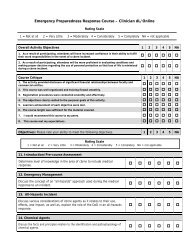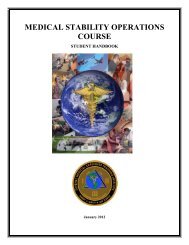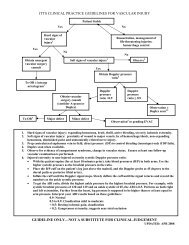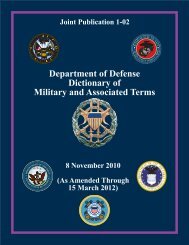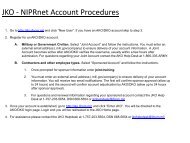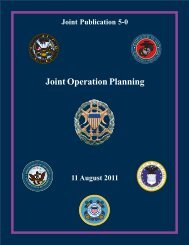JP 3-29 - Defense Technical Information Center
JP 3-29 - Defense Technical Information Center
JP 3-29 - Defense Technical Information Center
- No tags were found...
Create successful ePaper yourself
Turn your PDF publications into a flip-book with our unique Google optimized e-Paper software.
Execution and Assessmentd. Because of NGO and IGO sensitivities regarding negative perceptions generatedby working with military organizations, the term “information” instead of “intelligence”must be used. Those organizations must not have the perception that their neutrality iscompromised by providing intelligence to the military. Finally, consideration should alsobe given to answering the intelligence requirements of adjacent task forces as well astheater- and national-level requirements. Classification and releasability standards forintelligence and sensitive information should be determined early in the planning processand reviewed as the operation proceeds.e. Foreign disclosure procedures should be put in place and utilized to the maximumextent feasible.(1) In order to share critical intelligence information with allies and coalitionpartners efficiently, US intelligence information should be written for release at thelowest possible classification level and given the fewest possible disseminationrestrictions within foreign disclosure guidelines. The J-2 must establish procedures andmethods for separating intelligence from sources and methods. Intelligence productionagencies often print highly classified reports in such a manner that compartmentedinformation is separated from intelligence that can be widely disseminated by a “tearline” (the J-2 and component intelligence staff officers keep information above the tearline and disseminate the intelligence below). Having intelligence production agenciesuse such tear lines will greatly facilitate intelligence sharing.(2) The joint force J-2, or delegated representative, obtains all the necessaryforeign disclosure authorization from <strong>Defense</strong> Intelligence Agency (DIA), nationalagencies, and other originators of controlled classified information as soon as possible toallow for the seamless transfer of information to foreign partners engaged in jointoperations. The efficient flow of intelligence will be enhanced by the assignment offormally trained personnel who are knowledgeable of foreign disclosure.7. <strong>Information</strong> Sharinga. <strong>Information</strong> sharing is critical to the efficient pursuit of a common humanitarianpurpose. Although many different groups and authorities can (and should) work inparallel, a collaborative information environment (CIE) facilitates information sharing.Constructing a CIE is not primarily a technology issue — effective, low-cost, networkequipment and data management systems exist today, and more are being developed.Rather, the challenges are largely social, institutional, cultural, and organizational. Theseimpediments can limit and shape the willingness of civilian and military personnel andorganizations to openly cooperate and share information and capabilities.b. The components of civil-military coordination consist of information and tasksharing and collaborative planning — all of which depend on communications andmanagement of data and information. The following issues, however, often complicateeffective civil-military coordination:IV-11



